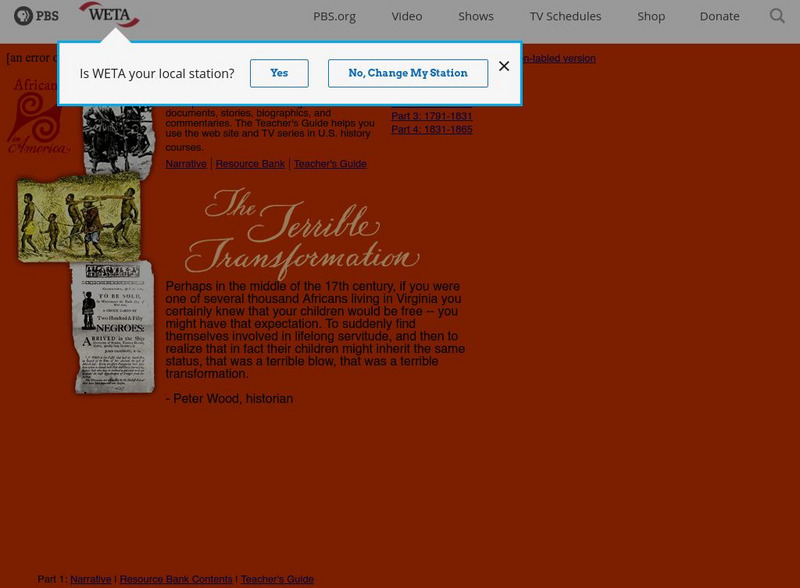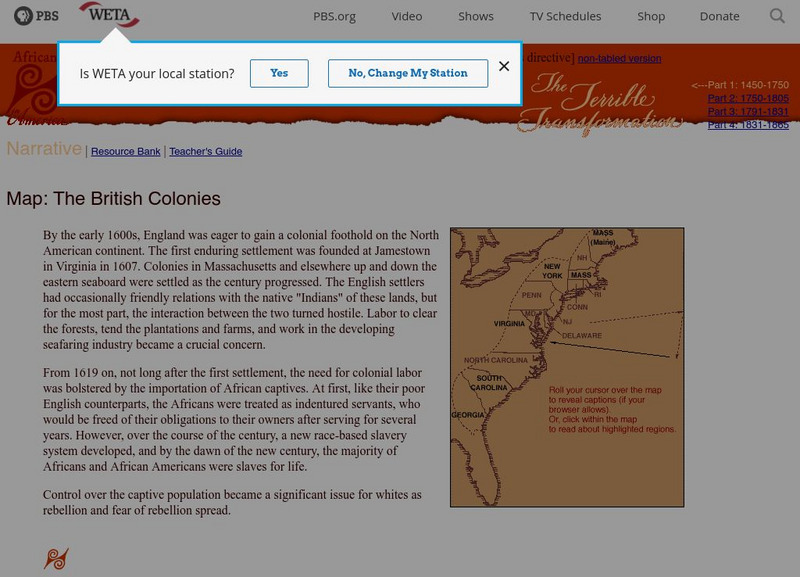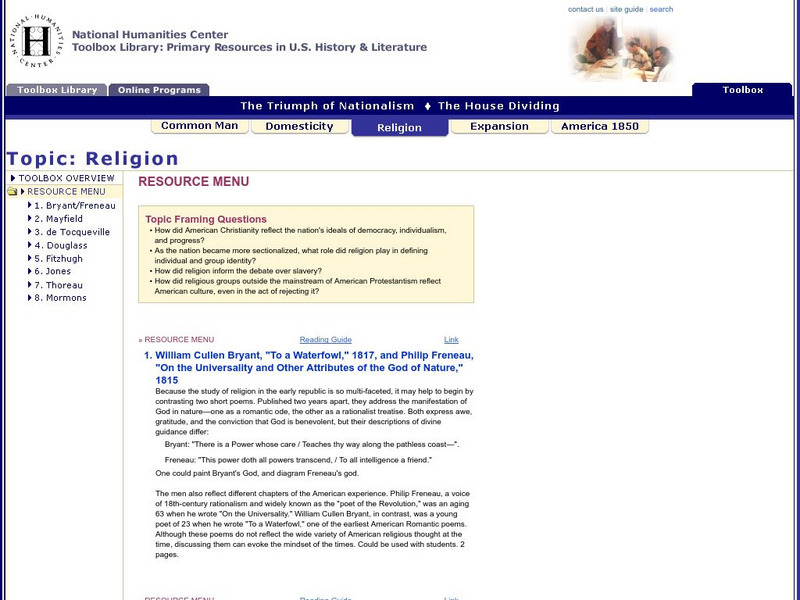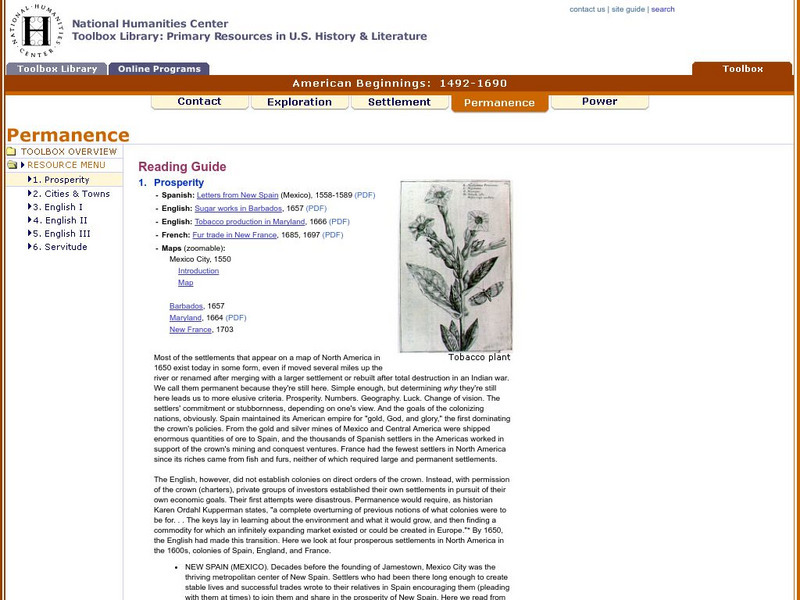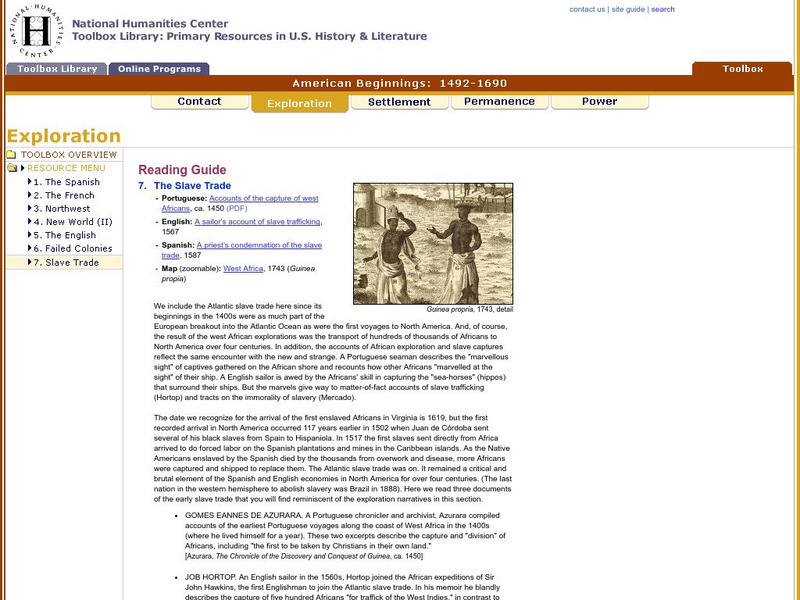Hi, what do you want to do?
Curated OER
A Colony is Born : Lesson 3 - Marking Time
Fifth graders refer to text and timeline to fill in a graphic organizer and timeline from 1492-1607. They participate in a class discussion that allows for speedy accumulation of events and fill in their own timelines. They work in small...
Curated OER
Silk Road Assessment
In this ancient trade routes instructional activity, middle schoolers respond to 10 multiple choice questions and 1 essay question about the Silk Road and its significance.
Curated OER
Sorting by Site: Missouri quarter reverse
Lewis and Clark took note of the animals common to their home state. As they traveled, they noticed that different places had different types of animals. Your class will use this model to compare and contrast elements that make up their...
Alabama Department of Archives and History
Alabama BEFORE the American Revolution
Did you know that prior to the American Revolution, Alabama was a part of the British empire and called New West Florida? Class members research the economic, political, and social realities of this territory and compare...
Curated OER
The Patchwork Path
Fourth graders investigate slavery by reading a book with their classmates. In this abolitionist movement activity, 4th graders read the story The Patchwork Path, and discuss the creation of the Underground Railroad. Students create...
Curated OER
Lending a Helping Hand
Students research the work of North American NGOs and select one to support with a financial contribution as a class. In this philanthropic research lesson plan, students consider the work of Benjamin Franklin, defining good citizenship...
Curated OER
Where Blues and Jazz Started
In this blues and jazz music worksheet, students read about the origins and basic concepts of blues and jazz music in 2 brief articles. Students then respond to 12 short answer questions regarding the music with its roots in slavery times.
Curated OER
Colonization
Students explore why the Americas attracted Europeans, why they brought enslaved Africans to their colonies, and how Europeans struggled for control of North American and the Caribbean.
Curated OER
Haiti: Exploration and Colonization
Tenth graders discuss what their prior knowledge of the exploration of the Americas/Caribbean and the history of the island of Haiti. They trace Columbus' journey from Spain to Hispaniola and locate Haiti in the Caribbean and read the...
Curated OER
Civil War and Reconstruction
Fourth graders investigate the Civil War by researching the state of Virginia. For this US History lesson, 4th graders identify Abraham Lincoln, James Chestnut and Fort Sumter, and discuss their roles in the start of the Civil...
Curated OER
A Colony is Born : Lesson 4 - What Went Wrong?
Fifth graders compare and contrast two early colonies and make a T chart. They list examples of worked well and what did not, and significant historical events. They use higher order thinking skills by deducing how different scenarios...
Curated OER
A Colony is Born : Lesson 2 - Sez Who?
Second graders increase their baseline knowledge of primary and secondary sources and the likenesses and differences of them with regard to a selected historical event.
Curated OER
Heroes and Heroines of the Underground Railroad System (UGRR)
Fourth graders choose one leader, either Tubman or Coffin, and write a persuasive summary paragraph that explains why the leader displays the character traits of a hero/heroine in the UGRR
PBS
Pbs: Africans in America
PBS offers a four-part series on the plight of African Americans from slave days to the end of the Civil War. Resources such as interactive maps, a Resource Bank, and Teacher's Guide are available.
PBS
Africans in America: Map of the British Colonies
Map of British Colonies and information from PBS on slavery from about 1600 to 1750. Some timelining of African American's lives in the New World.
PBS
Pbs Learning Media: The Abolitionist Map of America
Through an interactive map, tours, documents, images, and videos, explore the account of the abolitionist movement in America.
Digital Public Library of America
Dpla: Torn in Two: Mapping the American Civil War
This exhibition tells the story of the American Civil War both nationally and locally in Boston, Massachusetts, through maps, documents, letters, and other primary sources.
Other
Vox: 37 Maps That Explain the American Civil War
April 1865 was a momentous month in American history. On April 9, the Confederate army under Robert E. Lee surrendered to the Union forces of Ulysses S. Grant, effectively ending the Civil War. Then on April 14, the victorious President...
Library of Congress
Loc: The African American Odyssey: A Quest for Full Citizenship
Online exhibit from the Library of Congress explores black America's quest for equality from the early national period through the twentieth century. Exhibit contains a wealth of items including books, government documents, manuscripts,...
Curated OER
Etc: Maps Etc: Freedom and Slavery in the Early United States, 1790
A map of the United States and territories east of the Mississippi River in 1790, showing the areas of freedom and slavery at the time, including the territory of the Northwest, free by the Ordinance of 1787.
National Humanities Center
National Humanities Center: Toolbox Library: Triumph of Nationalism: America, 1815 1850: Religion
A collection of nine primary resources including historical documents, literary texts, visual images, and maps illuminated and contextualized by notes, thematic questions, and text-specific discussion questions for classroom instruction...
Huntington Library
Huntington Library: Triangular Trade
In this instructional activity, 5th graders learn about the many societal structures that developed in colonial days, including the conditions for self-government in America, the free-market economy, and the slavery system. Background...
National Humanities Center
National Humanities Center: Toolbox Library: Prosperity, American Beginnings: 1492 1690
Four original source accounts, and four related maps, of successful English, French, and Spanish settlements in North America and the Caribbean that explain the qualities of these settlements and their reasons for permanence and prosperity.
National Humanities Center
National Humanities Center: Toolbox Library: Slave Trade, American Beginnings: 1492 1690
A West African map and three accounts of the development of slave acquisition display the process and the brutality of the Atlantic slave trade.


















